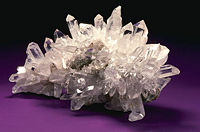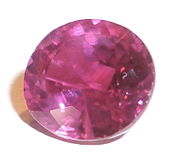Mohs scale of mineral hardness
The Mohs scale of mineral hardness characterizes the scratch resistance of various minerals through the ability of a harder material to scratch a softer material. It was created in 1812 by the German mineralogist Friedrich Mohs and is one of several definitions of hardness in materials science. The method, however, is of great antiquity, having first been mentioned by Pliny the Elder in his Naturalis Historia circa A.D. 77.
Contents |
Minerals
Mohs based the scale on ten minerals that are all readily available. As the hardest known naturally occurring substance, diamond is at the top of the scale. The hardness of a material is measured against the scale by finding the hardest material that the given material can scratch, and/or the softest material that can scratch the given material. For example, if some material is scratched by apatite but not by fluorite, its hardness on the Mohs scale would fall between 4 and 5.
The Mohs scale is a purely ordinal scale. For example, corundum (9) is twice as hard as topaz (8), but diamond (10) is almost four times as hard as corundum. The table below shows comparison with absolute hardness measured by a sclerometer, with pictorial examples.
| Hardness | Mineral | Absolute Hardness | Image |
|---|---|---|---|
| 1 | Talc (Mg3Si4O10(OH)2) | 1 |  |
| 2 | Gypsum (CaSO4·2H2O) | 2 |  |
| 3 | Calcite (CaCO3) | 9 |  |
| 4 | Fluorite (CaF2) | 21 |  |
| 5 | Apatite (Ca5(PO4)3(OH-,Cl-,F-) | 48 |  |
| 6 | Orthoclase (KAlSi3O8) | 72 |  |
| 7 | Quartz (SiO2) | 100 |  |
| 8 | Topaz (Al2SiO4(OH-,F-)2) | 200 |  |
| 9 | Corundum (Al2O3) | 400 |  |
| 10 | Diamond (C) | 1500 |  |
On the Mohs scale, a pencil lead has a hardness of 1; a fingernail has hardness 2.5; a copper penny, about 3.5; a knife blade, 5.5; window glass, 5.5; steel file, 6.5.[1] Using these ordinary materials of known hardness can be a simple way to approximate the position of a mineral on the scale.
Intermediate hardness
The table below incorporates additional substances that may fall between levels::
| Hardness | Substance or Mineral |
|---|---|
| 1 | Talc |
| 2.5 to 3 | pure gold, silver, aluminium |
| 3 | Calcite, copper penny |
| 4 | Fluorite |
| 4 to 4.5 | Platinum |
| 4 to 5 | Iron |
| 5 | Apatite |
| 6 | Orthoclase |
| 6 | Titanium |
| 6.5 | Iron pyrite |
| 6 to 7 | Glass, Vitreous pure silica |
| 7 | Quartz |
| 7 to 7.5 | Garnet |
| 7 to 8 | Hardened steel |
| 8 | Topaz |
| 8.5 | Chrysoberyl |
| 9 | Corundum |
| 9 to 9.5 | Carborundum |
| <10 | Ultrahard fullerite |
| 10 | Diamond |
| >10 | Aggregated diamond nanorods, Rhenium diboride |
See also
- hardness
- Brinell hardness
- Vickers hardness
References
- ↑ ""The Hardness of Minerals and Rocks" by William S. Cordua". Lapidary Digest (1998). Retrieved on 2007-08-19. Hosted at International Lapidary Association
- American Federation of Mineralogical Societies. "Mohs Scale of Mineral Hardness". Last Revised on April 21, 2007. Retrieved on August 19, 2007.
- Cordua, William S. "The Hardness of Minerals and Rocks". Lapidary Digest, c. 1990.
|
|||||